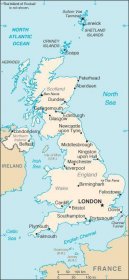| Introduction - United Kingdom: |
| Location - United Kingdom: |
| People - United Kingdom: |
| Government - United Kingdom: |
| Economy - United Kingdom: |
Economy overview | The UK, a leading trading power and financial center, is one of the quintet of trillion dollar economies of Western Europe. Over the past two decades, the government has greatly reduced public ownership and contained the growth of social welfare programs. Agriculture is intensive, highly mechanized, and efficient by European standards, producing about 60% of food needs with less than 2% of the labor force. The UK has large coal, natural gas, and oil reserves; primary energy production accounts for 10% of GDP, one of the highest shares of any industrial nation. Services, particularly banking, insurance, and business services, account by far for the largest proportion of GDP while industry continues to decline in importance. GDP growth slipped in 2001-03 as the global downturn, the high value of the pound, and the bursting of the new economy bubble hurt manufacturing and exports. Output recovered in 2004, to 3.2% growth, then slowed to 1.7% in 2005 and 2.7% in 2006. The economy is one of the strongest in Europe; inflation, interest rates, and unemployment remain low. The relatively good economic performance has complicated the BLAIR governments efforts to make a case for Britain to join the European Economic and Monetary Union (EMU). Critics point out that the economy is doing well outside of EMU, and public opinion polls show a majority of Britons are opposed to the euro. Meantime, the government has been speeding up the improvement of education, transport, and health services, at a cost in higher taxes and a widening public deficit. |
|
Gdp purchasing power parity | $1.93 trillion (2006 est.) |
|
Gdp official exchange rate | $2.346 trillion (2006 est.) |
|
Gdp real growth rate | 2.8% (2006 est.) |
|
Gdp per capita ppp | $31,800 (2006 est.) |
|
Gdp composition by sector | agriculture: 1%
industry: 25.6%
services: 73.4% (2006 est.) |
|
Labor force | 31.1 million (2006 est.) |
|
Labor force by occupation | agriculture: 1.4%
industry: 18.2%
services: 80.4% (2006 est.) |
|
Unemployment rate | 2.9% (2006 est.) |
|
Population below poverty line | 17% (2002 est.) |
|
Household income or consumption by percentage share | lowest 10%: 2.1%
highest 10%: 28.5% (1999) |
|
Distribution of family income gini index | 36.8 (1999) |
|
Inflation rate consumer prices | 3% (2006 est.) |
|
Investment gross fixed | 17.2% of GDP (2006 est.) |
|
Budget | revenues: $973 billion
expenditures: $1.04 trillion; including capital expenditures of $87 billion (2006 est.) |
|
Public debt | 42.2% of GDP (2006 est.) |
|
Agriculture products | cereals, oilseed, potatoes, vegetables; cattle, sheep, poultry; fish |
|
Industries | machine tools, electric power equipment, automation equipment, railroad equipment, shipbuilding, aircraft, motor vehicles and parts, electronics and communications equipment, metals, chemicals, coal, petroleum, paper and paper products, food processing, textiles, clothing, other consumer goods |
|
Industrial production growth rate | 0% (2006 est.) |
|
Electricity production | 363.2 billion kWh (2004) |
|
Electricity consumption | 345.2 billion kWh (2004) |
|
Electricity exports | 2.3 billion kWh (2004) |
|
Electricity imports | 9.8 billion kWh (2004) |
|
Oil production | 2.075 million bbl/day (2004 est.) |
|
Oil consumption | 1.827 million bbl/day (2004 est.) |
|
Oil exports | 1.956 million bbl/day (2004) |
|
Oil imports | 1.654 million bbl/day (2004) |
|
Oil proved reserves | 4.487 billion bbl (1 January 2005) |
|
Natural gas production | 95.97 billion cu m (2004 est.) |
|
Natural gas consumption | 98.47 billion cu m (2004 est.) |
|
Natural gas exports | 9.8 billion cu m (2004 est.) |
|
Natural gas imports | 12.3 billion cu m (2004 est.) |
|
Natural gas proved reserves | 589 billion cu m (1 January 2005 est.) |
|
Current account balance | -$57.68 billion (2006 est.) |
|
Exports | $468.8 billion f.o.b. (2006 est.) |
|
Exports commodities | manufactured goods, fuels, chemicals; food, beverages, tobacco |
|
Exports partners | US 13.9%, Germany 10.9%, France 10.4%, Ireland 7.1%, Netherlands 6.3%, Belgium 5.2%, Spain 4.5% (2006) |
|
Imports | $603 billion f.o.b. (2006 est.) |
|
Imports commodities | manufactured goods, machinery, fuels; foodstuffs |
|
Imports partners | Germany 12.8%, US 8.9%, France 6.9%, Netherlands 6.6%, China 5.3%, Norway 4.9%, Belgium 4.5% (2006) |
|
Reserves of foreign exchange and gold | $38.83 billion (August 2006 est.) |
|
Economic aid donor | ODA, $10.7 billion (2005) |
|
Debt external | $8.28 trillion (30 June 2006) |
|
Currency code | British pound (GBP) |
|
Exchange rates | British pounds per US dollar - 0.5418 (2006), 0.5493 (2005), 0.5462 (2004), 0.6125 (2003), 0.6672 (2002) |
|
| Communications - United Kingdom: |
| Transportation - United Kingdom: |
| Military - United Kingdom: |
This page was last updated on 16 September, 2007



